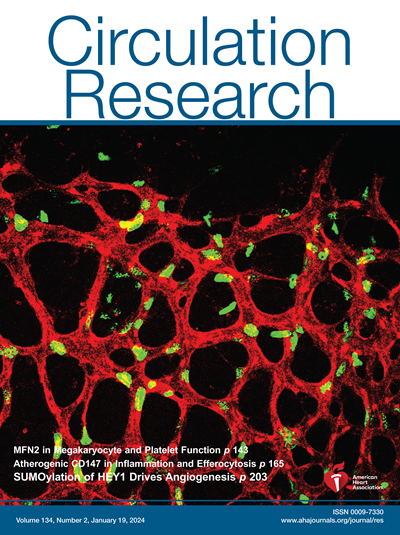Chromatin Rewiring by SETD2 Drives Lipotoxic Injury in Cardiometabolic HFpEF.
IF 16.5
1区 医学
Q1 CARDIAC & CARDIOVASCULAR SYSTEMS
引用次数: 0
Abstract
BACKGROUND Cardiometabolic heart failure with preserved ejection fraction (cHFpEF) is a highly prevalent and deadly condition. Histone 3 trimethylation at lysine 36 (H3k36me3)-a chromatin signature induced by the histone methyltransferase SETD2 (SET domain containing 2)-correlates with changes in gene expression in human failing hearts; however, its role remains poorly understood. This study investigates the role of SETD2 in cHFpEF. METHODS Chromatin immunoprecipitation sequencing and RNA sequencing were used to investigate H3k36me3-related transcriptional regulation. Mice with cardiomyocyte-specific deletion of SETD2 (c-SETD2-/-) were generated and subjected to high-fat diet feeding and L-NAME treatment for 15 weeks to induce cHFpEF. Cardiac function and exercise tolerance were assessed by echocardiography and treadmill exhaustion test. A selective pharmacological inhibitor of SETD2, EZM0414, was also tested in cHFpEF mice. Mechanistic experiments were performed in cultured cardiomyocytes exposed to palmitic acid. SETD2 signaling and the effects of EZM0414 were also investigated in cardiomyocytes from patients with cHFpEF and control donors. RESULTS SETD2 was upregulated in cHFpEF mouse hearts, and its chromatin mark H3k36me3 was involved in lipid metabolism and highly enriched on the promoter of the Srebf1 gene, encoding for SREBP1 (sterol regulatory binding protein 1). SETD2 activation in cHFpEF led to SREBP1 upregulation, triglyceride accumulation, and lipotoxic damage. Of note, cardiomyocyte-specific deletion of SETD2 in mice prevented heart failure with preserved ejection fraction-related hypertrophy, diastolic dysfunction, and lung congestion while improving exercise tolerance. SETD2 deletion blunted H3K36me3 enrichment on Srebf1 promoter, thus leading to a marked rewiring of the cardiac lipidome and restoration of autophagic flux. In vivo treatment with the SETD2 inhibitor EZM0414 recapitulated the effects of SETD2 deletion. Silencing of SETD2 in palmitic acid-treated cardiomyocytes prevented SREBP1 upregulation, whereas SETD2 overexpression mirrored lipotoxic damage. Finally, SETD2 was upregulated in left ventricle specimens from patients with cHFpEF while EZM0414 attenuated cardiomyocyte stiffness. CONCLUSIONS Targeting SETD2 might prevent lipotoxic injury in cHFpEF.SETD2染色质重布线驱动心脏代谢性HFpEF的脂毒性损伤。
背景:保留射血分数的心代谢性心力衰竭(cHFpEF)是一种非常普遍和致命的疾病。组蛋白甲基转移酶SETD2 (SET domain containing 2)诱导的染色质特征赖氨酸36 (H3k36me3)的组蛋白3三甲基化与人类衰竭心脏基因表达的变化相关;然而,人们对它的作用仍然知之甚少。本研究探讨了SETD2在cHFpEF中的作用。方法采用染色质免疫沉淀测序和RNA测序方法研究h3k36me3相关的转录调控。产生心肌细胞特异性缺失SETD2 (c-SETD2-/-)的小鼠,并给予高脂肪饮食喂养和L-NAME治疗15周以诱导cHFpEF。通过超声心动图和跑步机疲劳试验评估心功能和运动耐量。SETD2的选择性药理学抑制剂EZM0414也在cHFpEF小鼠中进行了测试。在培养的心肌细胞中进行了暴露于棕榈酸的机制实验。在cHFpEF患者和对照供者的心肌细胞中也研究了SETD2信号和EZM0414的作用。结果SETD2在cHFpEF小鼠心脏中表达上调,其染色质标记H3k36me3参与脂质代谢,并在Srebf1基因启动子上高度富集,编码SREBP1(甾醇调节结合蛋白1)。SETD2在cHFpEF中的激活导致SREBP1上调、甘油三酯积累和脂毒性损伤。值得注意的是,小鼠心肌细胞特异性缺失SETD2可以预防心力衰竭,保留射血分数相关的肥厚、舒张功能障碍和肺充血,同时提高运动耐受性。SETD2缺失减弱了Srebf1启动子上H3K36me3的富集,从而导致心脏脂质组的显著重新连接和自噬通量的恢复。SETD2抑制剂EZM0414的体内治疗重现了SETD2缺失的效果。在棕榈酸处理的心肌细胞中,SETD2的沉默阻止了SREBP1的上调,而SETD2的过表达反映了脂毒性损伤。最后,在cHFpEF患者的左心室标本中,SETD2上调,而EZM0414减弱心肌细胞僵硬度。结论靶向SETD2可预防cHFpEF的脂毒性损伤。
本文章由计算机程序翻译,如有差异,请以英文原文为准。
求助全文
约1分钟内获得全文
求助全文
来源期刊

Circulation research
医学-外周血管病
CiteScore
29.60
自引率
2.00%
发文量
535
审稿时长
3-6 weeks
期刊介绍:
Circulation Research is a peer-reviewed journal that serves as a forum for the highest quality research in basic cardiovascular biology. The journal publishes studies that utilize state-of-the-art approaches to investigate mechanisms of human disease, as well as translational and clinical research that provide fundamental insights into the basis of disease and the mechanism of therapies.
Circulation Research has a broad audience that includes clinical and academic cardiologists, basic cardiovascular scientists, physiologists, cellular and molecular biologists, and cardiovascular pharmacologists. The journal aims to advance the understanding of cardiovascular biology and disease by disseminating cutting-edge research to these diverse communities.
In terms of indexing, Circulation Research is included in several prominent scientific databases, including BIOSIS, CAB Abstracts, Chemical Abstracts, Current Contents, EMBASE, and MEDLINE. This ensures that the journal's articles are easily discoverable and accessible to researchers in the field.
Overall, Circulation Research is a reputable publication that attracts high-quality research and provides a platform for the dissemination of important findings in basic cardiovascular biology and its translational and clinical applications.
 求助内容:
求助内容: 应助结果提醒方式:
应助结果提醒方式:


